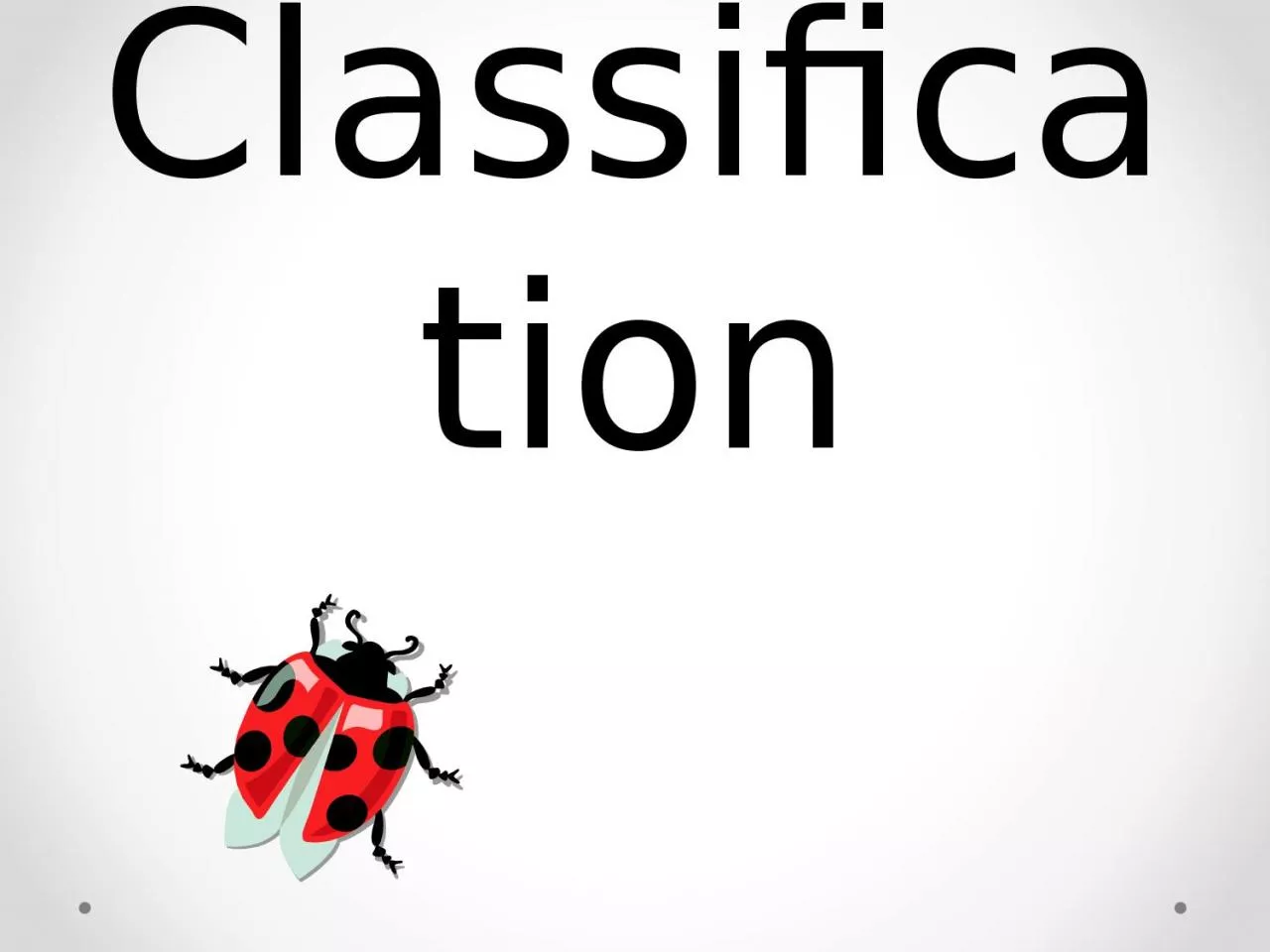

How do scientists classify living organisms Standards S7L1 Obtain evaluate and communicate information to investigate the diversity of living organisms and how they can be compared scientifically ID: 1026420
Download Presentation The PPT/PDF document "Classification Essential Question:" is the property of its rightful owner. Permission is granted to download and print the materials on this web site for personal, non-commercial use only, and to display it on your personal computer provided you do not modify the materials and that you retain all copyright notices contained in the materials. By downloading content from our website, you accept the terms of this agreement.
1. Classification
2. Essential Question:How do scientists classify living organisms?
3. Standards:S7L1. Obtain, evaluate, and communicate information to investigate the diversity of living organisms and how they can be compared scientifically.a. Develop and defend a model that categorizes organisms based on common characteristics.b. Evaluate historical models of how organisms were classified based on physical characteristics and how that led to the six kingdom system (currently archaea, bacteria, protists, fungi, plants, and animals). (Clarification statement: This includes common examples and characteristics such as, but not limited to, prokaryotic, eukaryotic, unicellular, multicellular, asexual reproduction, sexual reproduction, autotroph, heterotroph, and unique cell structures. Modern classification will be addressed in high school.)
4. What is classification?Classification is the process of arranging organisms into groups based on similarities.
5. Why should things be classified?Classification makes things easier to find, identify, and study.
6. Scientists use a system of classification to organize and name living organisms.
7. Levels of classification from largest to smallest: KingdomPhylumClassOrder FamilyGenus SpeciesScience Rap – Zendaya and Bella https://www.youtube.com/watch?v=J-FTy6L_yYoClassification of Organisms https://www.youtube.com/watch?v=6WPBA4a6NjUThe Best Classification Rap with Lyrics https://www.youtube.com/watch?v=gj15UF08lUI
8.
9. Take a minute to create a mnemonic device to help you remember the levels of classification from largest to smallest.Examples:King Phillip came over for grape soda.King Phillip came over from Germany Saturday.King Phillip can order fresh green salad
10. Mohler’s mnemonicKids …….KingdomPrefer ……..PhylumCheese ……..ClassOver ………OrderFried ……..FamilyGreen ……..GenusSpinach …….Species
11. .Is it necessary to go through the entire seven-level classification system to identify a plant or animal?
12. Latin and Greek words are used to give organisms a name (similar to a first and last name) for identification.The GENUS and SPECIES names are enough…Thus, the scientific name for the brown squirrel is Tamiasciurus hudsonicus
13. A scientific name is the same no matter how many common names an organism might have.(Notice that scientific name are always written in italics) Genus + species = scientific name Capital lower case
14. Classification of Living Things Video:https://www.youtube.com/watch?v=5hMqYiWry8U Mr. Parr: Classification Song (modified w/pics) https://www.youtube.com/watch?v=wgivfVM9yOQ Mr. Parr: Classification Song (same but with words) https://www.youtube.com/watch?v=dnF_UdPbJZ0
15. Other examples: Ursus horribilis for grizzly bear Felis domesticus for house cathttps://www.youtube.com/watch?v=aJUB4R5j0dI
16. A dichotomous key is a tool used to identify organisms.A dichotomous key asks a series of questions that can be answered by yes or no.Dichotomous keys work like a funnel. It narrows down the characteristics to a specific organism.
17. Here are creatures we don’t know!Lets choose oneHow to use a Dichotomous Key?
18. How to use a Dichotomous Key?Choose only one creature at a time.
19. Read steps 1a and 1bDecide which statement is trueHow to use a Dichotomous Key?1b is true
20. How to use a Dichotomous Key?Then follow the directions after that step.Go to Step 5
21. How to use a Dichotomous Key?At choice 5, you make another dichotomous choice5a is true so Go to Step 6
22. Keep going until you come to a step that gives you the creature’s name.CHow to use a Dichotomous Key?6 a. The creature has one antennae Go to Step 7.
23. Dichotomous Key Activities
24. Most scientists today use a system that includes six kingdoms.
25. KingdomsMoneran:ArchaebacteriaBacteria3. Protists4. Fungi5. Plants6. Animals
26.
27.
28. Essential VocabularyProkaryote (no nucleus) vs. Eukaryote (has a nucleus)Producer – Makes its own food (Also called an Autotroph)Heterotroph – Feeds on or consumes other organisms (Also called a Consumer)Decomposer – Breaks down dead or decaying materials to get energy (type of Heterotroph)Asexual vs. Sexual Reproduction
29. Use the Six Kingdoms Classification Chart to take NotesLeastComplex toMostComplex
30. Bacteria
31. Bacteria (Eubacteria)Prokaryote (no nucleus)One-celled (single-celled; unicellular)Gets energy from sunlight(producer/autotroph)Breaks down materials in dead or decaying organisms (decomposer/heterotroph)Asexual Reproduction by Binary FissionReproduces in a short amount of timeCan be helpful or harmful
32.
33. Archaebacteria
34. ArchaebacteriaProkaryoteOne-celled (single-celled or unicellular)Gets energy from sunlight(producer/autotroph)Breaks down materials in dead or decaying organisms (decomposer/heterotroph)Asexual reproduction by binary fissionReproduces in a short amount of timeFound in extreme environments [very hot, very cold, very salty, etc.]Different chemical makeup than bacteria
35. Protists
36. ProtistsEukaryoteMostly one-celled but some simple multicellularMake their own food (producer/autotroph)Eat other organisms (consumer/heterotroph)Break down or absorb materials from dead or decaying organisms (decomposer/heterotroph)Mostly Asexual reproduction, but some sexual reproductionClassified based on how they obtain their energy (plant-like, fungus-like, animal-like)Most diverse kingdom (the “leftovers”)
37. ProtistsAmeobaEuglenaParameciumAlgaeDiatom
38. Fungi
39. FungiEukaryoteMostly multicellularBreaks down or absorbs materials from dead or decaying organisms (decomposer/heterotroph)Asexual or Sexual reproductionCan be helpful or harmfulExamples: Mushrooms, Mold, Yeasts
40. Fungi
41. Mr. Parr: Fungi Song http://www.youtube.com/watch?v=H15Po5vHiDs
42. PlantsEukaryoteMulticellularProducer/Autotroph (Photosynthesis)Asexual or Sexual reproduction
43. AnimalsEukaryoteMulticellularConsumer/HeterotrophSexual reproduction
44.